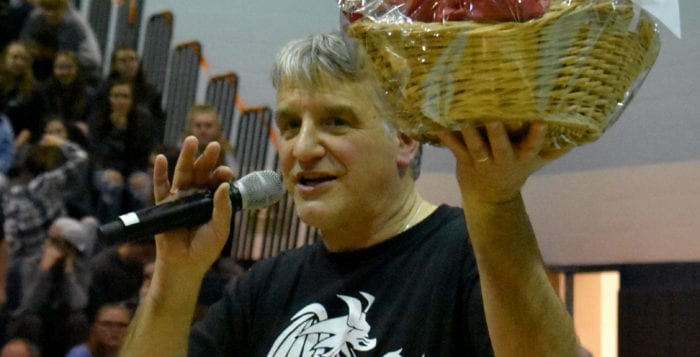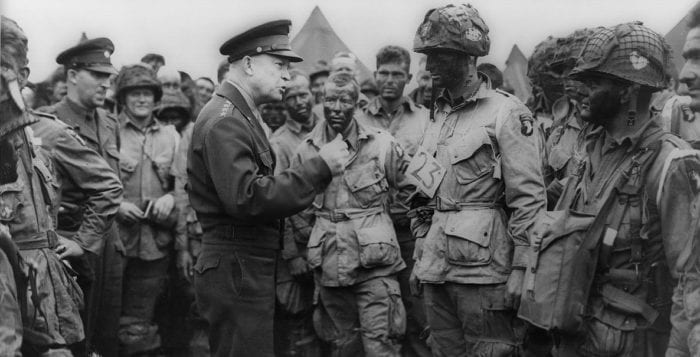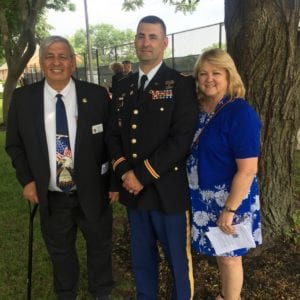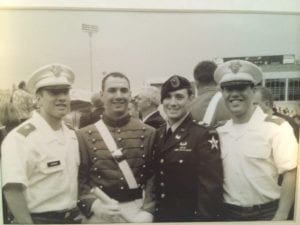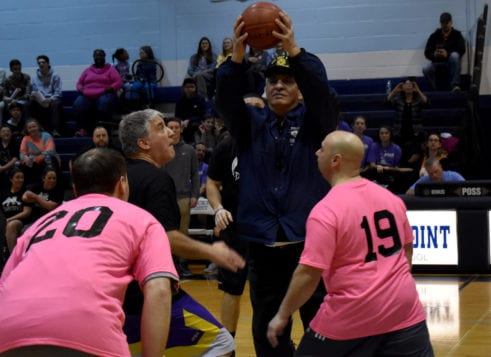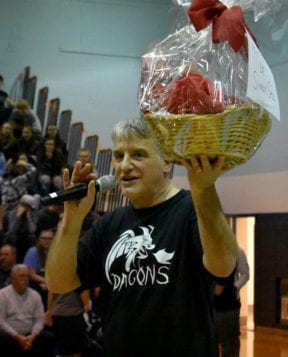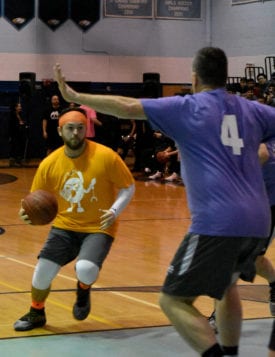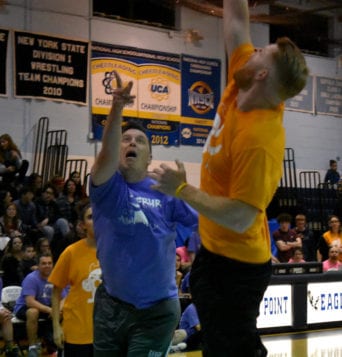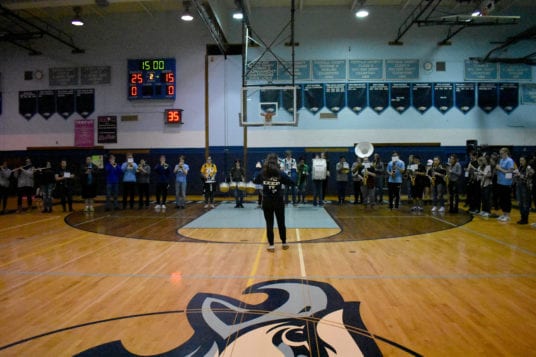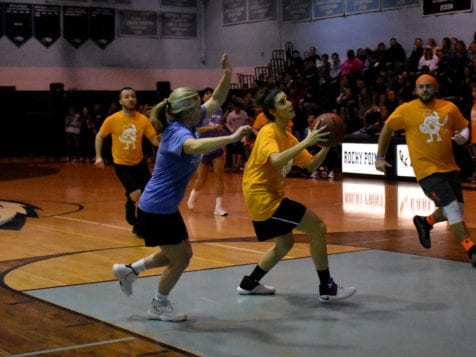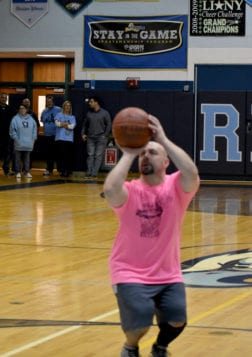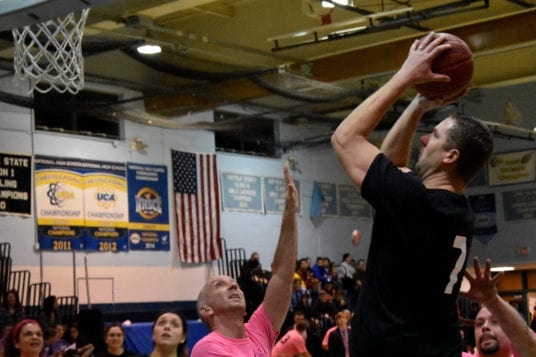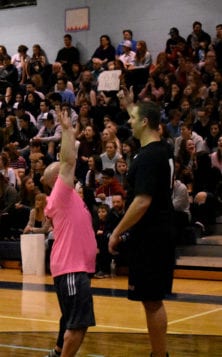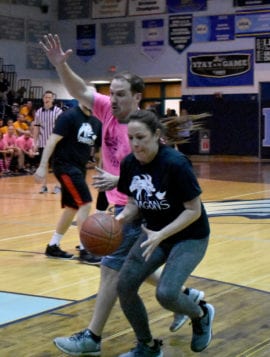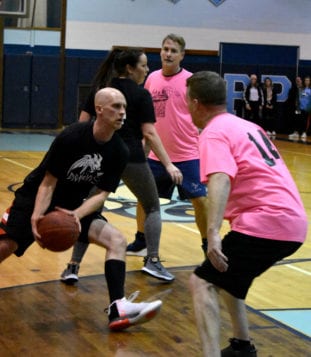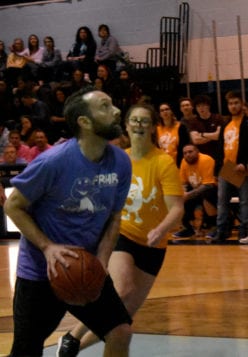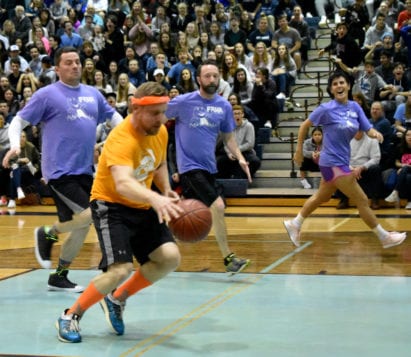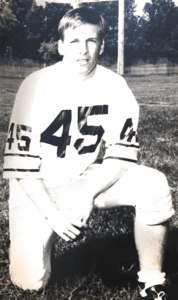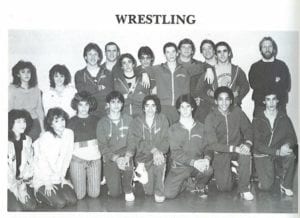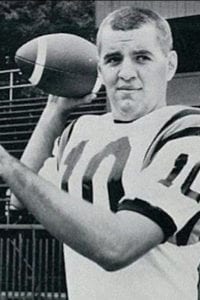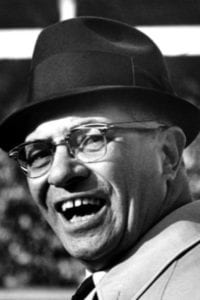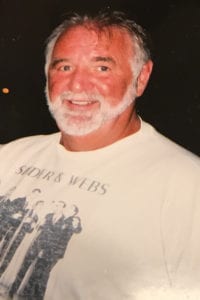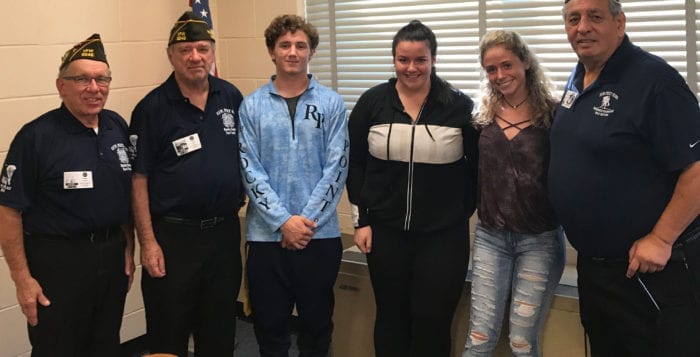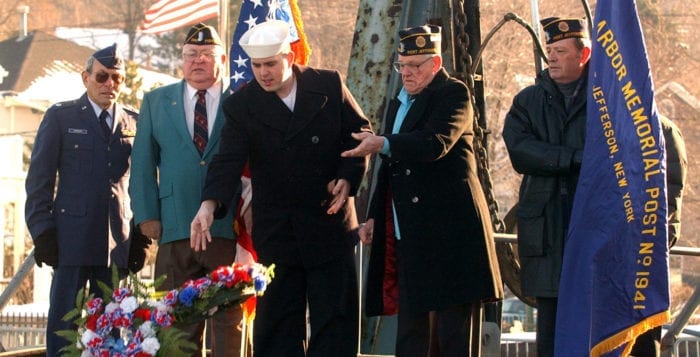By Rich Acritelli
“America is never wholly herself unless she is engaged in high moral principle. We as a people have such a purpose today. It is to make kinder the face of the nation and gentler the face of the world.”
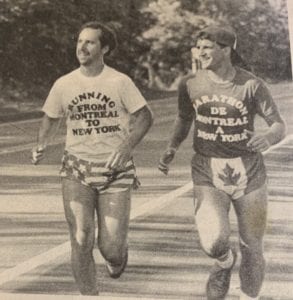
These words of service, which were spoken by the late President George H.W. Bush, are the lifelong giving code of Brooke R. Bonomi. He is a social studies teacher, coach and adviser who after 33 years in education will be retiring from Rocky Point High School. This distinguished educator has devoted his entire life to carrying out local and national tasks toward the betterment of his own home community and that of this North Shore school district.
Bonomi’s story began many years ago as a native of Woodside, Queens, who had moved to Syosset when he was 8 years old. This 57-year-old teacher vividly recalled a happy home life that saw his father work as a New York City firefighter and his mom was a housewife who cared for their three children. With a big smile, Bonomi laughs at his memories of playing endless hours of manhunt, competing through soccer and lacrosse and running many miles through the hills of eastern Nassau County and western Suffolk County. Running was a strong fit for Bonomi, who excelled at this sport in college and later ran the Montauk and Long Island marathons.
As a capable student-athlete, Bonomi was also the senior class president for Syosset High School. Always armed with a big smile and a unique personality, he created a contest among the student body titled “Why I Want to Go to the Prom with Brooke Bonomi.” As he mentioned this memory, Bonomi laughed and explained some of his fellow peers perceived this event as being pathetic, while he always saw it as a genius way to garner support for a school function. During his senior year, Bonomi was a three-sport athlete who was recruited by Johns Hopkins, University at Albany and Boston University to play soccer. To make life economically easier for his father, Bonomi received an appointment to the U.S. Coast Guard Academy in New London, Connecticut.
In 1980, this native of Syosset entered the service where he planned to earn a military education with the chance of playing soccer. While he made it through basic training and conducted sea operation on the Eagle, this military institution was not a good choice for Bonomi. Although he liked being in uniform and the camaraderie of the military, he struggled with his grades and the rigidness of this school, and he was honorably discharged after his first year. In 1981, Bonomi returned home and made plans to enter SUNY Oneonta, where he later majored in political science and speech communication.
It was at this school that Bonomi flourished with his own independence and creativity. Always a fan of music and performances, he and his friends established the Wondering Winter Wonder Men. This group sang two Christmas songs for a $1 to provide holiday cheer to the students while raising money for charity. Bonomi was also the captain of the cross-country team where he distinguished himself. With his friends, he ran the grueling length from Oneonta to Fire Island and from Montreal, Canada, to Hudson, New York, which was located just south of Albany. During these exhausting journey’s, he traveled a long way on foot and when he needed to rest, Bonomi slept on the lawns of people’s houses. With his witty sense of humor, he was also the disc jockey for the university radio station, worked at a local restaurant, was a resident’s assistant within the student dorms and delivered furniture. This was a golden time for Bonomi as he played sports, ran, worked various jobs and established his own sense of free will he would later use as an educator. Always an avid reader and analyst of history and political science, Bonomi appreciated both his liberal and conservative professors who allowed him to freely present his own views on these subjects. While Bonomi is a free spirit that is often pulled in many directions, he has an agile mind which has allowed him to fully express knowledgeable beliefs on many historical and political topics of discussion.

Once he graduated college in 1985, Bonomi believed that he was going to enter the Peace Corps. It was not until he went home to Syosset that a local neighbor and New York City social studies teacher expressed to Bonomi that he should enter education. Again, Bonomi went back to Oneonta and was enrolled in the education program to enter a field that would become his life’s work. Bonomi learned that there were positions opening up at Longwood Central School District. When he was looking at a map to locate Middle Island, he noticed that Rocky Point was not too far from this district. This Nassau County man learned of Rocky Point through a shirt that his friend wore about this town and school.
In 1986, Bonomi walked into the main office of the Rocky Point High School and ran into longtime teacher, administrator and coach, Michael P. Bowler. This former assistant principal was leaving teaching as a social studies teacher and entering administration. Bowler was the first person that Bonomi met in this entire district and he recollected, “It was in a way serendipitous that Brooke walked into the office that day because we needed to hire a teacher to replace me. I spoke to Brooke for quite some time and I could see that he was full of positive energy and enthusiasm and grounded in a deeply rooted value system … I just had a feeling that he would make a great addition to our school and community. The rest is history.”
Unlike the urban areas of Syosset, Bonomi enjoyed the rural feeling of Rocky Point, dominated as it was by the beauty of the conservation preserve located behind the high school. Bonomi was always known for his enthusiasm, but he was a little hesitant to be involved in different activities. Dan Galvin, the principal of the high school, wanted him to start coaching. At first, Bonomi refused to do so, as he wanted to allocate enough time toward lesson planning for the rigors of his new assignment as a seventh-grade American history teacher. He was originally at the crossroads of the high school, as he was one of the youngest employees to be hired at a time when there were few jobs in this market. Right away he showcased his unique teaching strategies, showing numerous film clips tied to his teaching content, writing songs like “Born an Iroquois,” and even teaching about the brutal cold weather that Continental soldiers had to endure at Valley Forge by standing in a bucket of ice.
As he became more comfortable with his instructional routines, Bonomi coached junior high lacrosse. Since 1986, Bowler and Bonomi have had a tight bond that saw them mold students through education and athletics. As a athlete, Bonomi coached girls junior high, junior varsity and varsity soccer. He ran with his players and personified a can-do attitude through times of both victory and defeat. At a low point during one game, the parents of his own players were openly criticizing their soccer abilities. As the girls were competing, he walked over to the parents and told them to lay off their own kids, as they were doing their best, during a difficult time. This action cemented a trademark of loyalty that Bonomi always presented to his students and athletes that he instructed.
In 1988, Bonomi brought his musical talents to the students of Rocky Point through his well-known organization of the Singing Santas. This group originally presented musical holiday spirit to the nursing homes, soup kitchens and local Veterans of Foreign Wars posts. Three years later, Galvin expressed to Bonomi that while he was doing an outstanding job outside of the school, there were parents who wanted him to sing for the student body. This began the legacy of a club that spanned from 1988 to 2016. He started the process of creating Christmas skits, playing song parodies that resembled the lyrics of Bruce Springsteen, the Blues Brothers, Bon Jovi, Green Day and Dave Mathews. Bonomi took many artistic chances over the years that ended up making this club into a dynamic legacy.
This success did not happen overnight, but through the combined determination of himself, the students and staff. Over several decades, Bonomi always promoted colorful skits, the Artic Horns and choirs of students who sang and danced to songs written by Bonomi. Social studies teacher Chris Nentwich was a key member of the Singing Santas who could be counted on to perform any type of acting role. He portrayed Jack Nicholas as Colonel Nathan R. Jessup from the film “A Few Good Men.” This satire was written by Scott Lindsay and the main part of “Colonel Ketchup” was acted by Nentwich, with support from Anthony Nobre, Sherin Shanahan and Andrew Aschettino. Through the colorful words of Lyndsay, he created a unique mini-play that saw the drama of “A Few Good Men,” with the humor of “My Cousin Vinny” through a comedic court room performance that saw Santa Claus put on trial. These were the traits of the Bonomi creed that saw both teachers and students working together to bring an unusual notion come to life. These performances gained the approval of a cheering auditorium.
A key figure in the Bonomi story is fellow social studies teacher James McCormack. This educator never turned down any type of request by Bonomi for this Christmas production. His favorite part of the Singing Santas was the “Benny Hill” chase scene between Santa Claus and the Grinch. Like that of Nentwich, McCormack was a main figure during these shows and he fully believed that, “There were a million moving pieces and a lot that could have gone wrong, but that old Bonomi magic kicked in and it all worked flawlessly,” McCormack recalled. “That is what Singing Santa’s was — a symphony of controlled chaos with Brooke as the maestro. It was always a joyous experience.”
At the final show for the Singing Santas in 2016, the school was filled with students and their family members that had traveled near and far to thank Bonomi for the countless hours that he spent presenting this enormous pageant. Next to Bonomi was the musical talents of Michael Conlon, a guidance counselor who had been a member of several bands since his youth in Sayville. While Bonomi showed his genius through being an off the cuff individual, Conlon personified a balance in music to personally sing songs. They immediately connected, and Conlon stated, “The memories that I have of the Singing Santas experience will forever bring a smile to my face as it did so many students over the last twenty-five years to perform in many different venues.”
Joseph A. Cognitore, the commander of Post 6249 Rocky Point Veterans of Foreign Wars, always requested the help of the Santas to play for their annual holiday party. Cognitore was always amazed at the role of the students and he expressed that “Bonomi was a constant fixture to bring smiles to all of the people, especially the children that watched these shows. Over the years, he never hesitated to help veterans that were struggling at home or were serving overseas in combat areas.”
Another activity and immense pride for the school that Bonomi led over the last several years was the Be a Nicer Neighbor Club. This organization was originally established from a lesson on the Progressive Era, which Bonomi taught on the need for people to be respectful to each other. Bonomi credited Galvin for promoting the charter beliefs of this group and Principal Bill Caulfied for making it into a reality by formerly making it into a yearly club.
In the early morning hours, Bonomi and the students cooked breakfast for the staff members, they made food for the homeless and school bus drivers. During the colder months, his students organized food and clothing drives and in the spring they conducted car washes. He helped build two 9/11 memorials placed in front of the school to remember the four lost graduates from Rocky Point. Just recently, he presided over Live Like Susie event to recall the positive joy of Susie Facini and to honor those current students that presented her values of kindness and devotion to the school. For many years, he ran the Senior Citizen Prom for the older residents of the North Shore. Bonomi had the students dress up as waiters, they played music and even ran the Pete Rose casino. He has taken students numerous times to Broadway shows and walked over the Brooklyn Bridge and to Madame Tussauds Wax Museum in New York City.
There has been countless whiffle ball games, square dances, chess matches, after-school films and meetings where he presented his most recent plans to aid society and the nation. Always next to him were staff members where Bonomi is seen exhibiting a dynamic sense of camaraderie. He showcased this through efforts to help the misfortunate in Hubner’s Homeless Helpers. Social worker Jennifer Zaffino has been at pivotal friend at Bonomi’s side for years to promote these social and economic programs. Zaffino, with a immense smile, wanted to thank Bonomi for the “many beautiful, behind-the-scene stories of what comes of most of the fundraised money.” The money is allocated to an account for students in need and has been utilized to help adolescents who experience financial hardship. “This is a small, but perfect example of how impactful Brooke’s ‘work’ has been for our students and their families,” she said.
And the culmination of his many projects was supremely demonstrated this past winter through the Wounded Warrior Basketball Game. The expertise that Bonomi showed was a colossal effort in creating four teams of players comprised of administrators, teachers, aides, security guards and groundskeepers. It was a student-centered game, as they were the coaches who made draft picks and trades through commentated announcements by Athletic Director Charlie Delargey. This event completely packed the gym, had a massive raffle, Simon Says for the children, shirts that were thrown to crowd and left many people wondering how Bonomi was able to make this event into a massive success. Bowler has watched these ongoing achievements by Bonomi and he stressed that this teacher “has always taught the students around him the value and the importance of reaching out and helping others through community service, and he did it in a way that made it fun for them.”
But while Bonomi has had the support of teachers, staff members and students, none of these vital programs would have been made possible without the loving support of his family. He credits the confidence that he received from the loving support of his wife, Eileen, who has stood by him during every activity. She has been the constant source of encouragement and the main cog of the family to completely guide this household. Bonomi, who is immensely busy, is always known to have stated, “that while it is important to help others, your greatest impact will be on your own children.” As a proud and devoted man to his family, he has utter happiness when looking at his children who are all now young adults.

Currently, his son Colin graduated from Scranton University and is employed at a finance firm. His older boy Ryan excelled at his studies at Providence University and now is enrolled in law school where he is working with the Justice Department in Boston, Massachusetts. Lauren, his youngest child, is studying to be a physician’s assistant at Villanova University. Ever the sports fan, Bonomi watches Villanova’s basketball games and likes going to the Big East Tournament at Madison Square Garden. He loved traveling to Woodloch Pines Resort in Pennsylvania and accompanying his wife and children to see the Zac Brown Band at Citi Field. With his family, Brooke has been supportive of his church, where he has organized youth groups, sang at holiday events and sold Christmas trees. While Bonomi brushes aside any personal acknowledgments that praise his talents as a teacher, he has been recognized several times as an educator of the year through different organizations and his church and home town has publicly thanked him for being such a selfless individual.
As it has not yet hit many of us how hard the loss of Bonomi will be for the high school in September, it will be noticeable not to hear his keys jingling, the sight of him giving out raffle tickets for his Friday raffle and his contagious laughter. One thing is for certain, that many of the senior staff members will have to do more to ensure that the traditions that this educator created over the last several decades are continued from one year to the next for the students of Rocky Point High School.
Well, Bonomi will not be in the school for this upcoming year, but his presence will always be felt by the many lives of the staff and students that he has touched since 1986. You can believe that Bonomi will continue to stay active with his family and will continue doing all that he can do on a daily basis to help his fellow citizens in every possible way. Thank you to Brooke R. Bonomi for making the North Shore into a better place.
Rich Acritelli is a social studies teacher at Rocky Point High School and an adjunct professor of American history at Suffolk County Community College.

